Comparing the Cold-Cranking Performance of Lead-Acid and Lithium Iron Phosphate Batteries at Temperatures below 0 °C
Abstract
1. Introduction
2. Materials and Methods
3. Results and Discussion
3.1. Capacity Test
3.2. First Pulse of the Cold-Cranking Test
3.3. Second Pulse of the Cold-Cranking Test
4. Conclusions
Author Contributions
Funding
Institutional Review Board Statement
Informed Consent Statement
Data Availability Statement
Acknowledgments
Conflicts of Interest
Appendix A

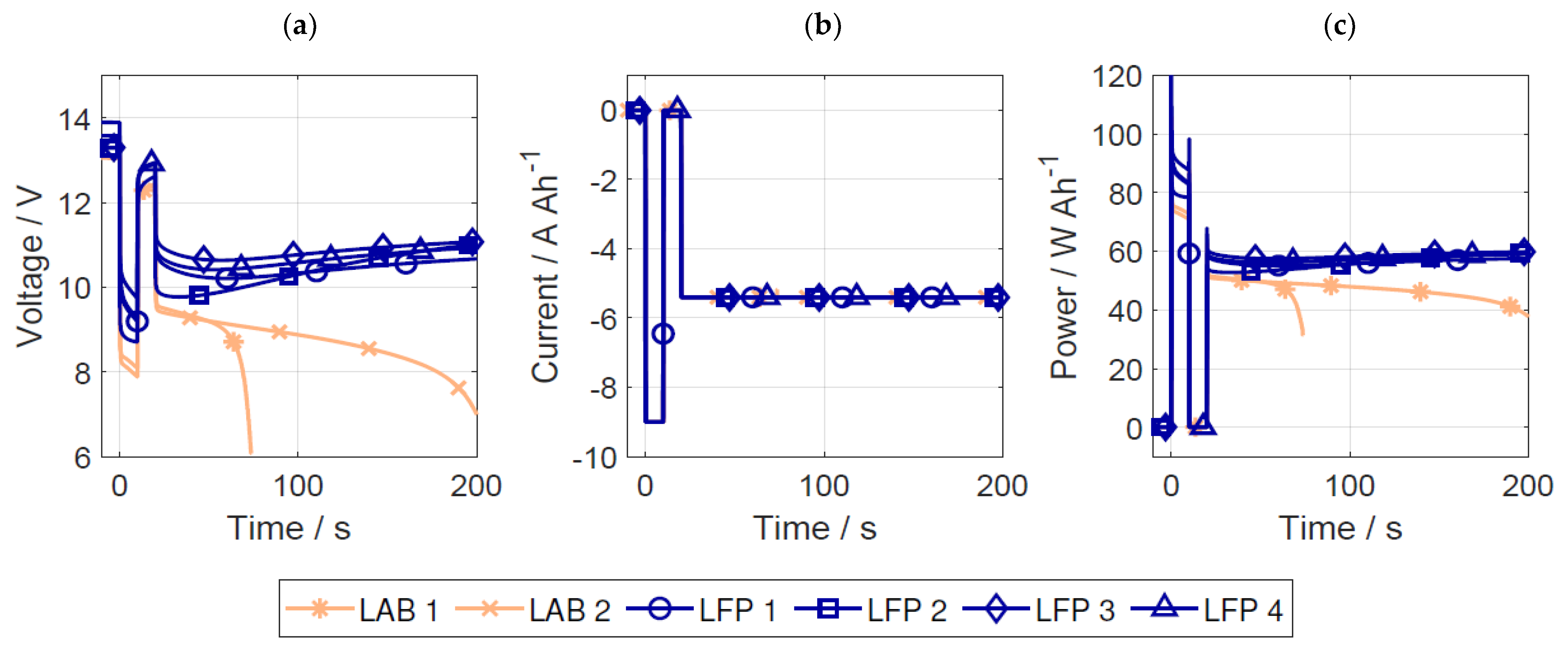

References
- Borgeest, K. Elektronik in der Fahrzeugtechnik; Springer Fachmedien: Wiesbaden, Germany, 2010; ISBN 978-3-8348-0548-5. [Google Scholar]
- Reif, K. Batterien, Bordnetze und Vernetzung; Vieweg+Teubner Verlag/GWV Fachverlage GmbH Wiesbaden: Wiesbaden, Germany, 2010; ISBN 978-3-8348-1310-7. [Google Scholar]
- Vergossen, D. Differenzierte Betrachtung und Bewertung von 12-Volt-Lithium-Ionen-Starterbatterien in PKW-Bordnetzen; Dissertation; Eric Cuvillier: Göttingen, Germany, 2018. [Google Scholar]
- Lead-Acid Starter Batteries, Part I: General Requirements and Methods of Test; European Committee for Electrotechnical Standardisation: Brussels, Belgium, 2019.
- Pischinger, S.; Seiffert, U. Vieweg Handbuch Kraftfahrzeugtechnik; Aktualisierte und erweiterte Auflage; Springer Vieweg: Wiesbaden, Germany, 2016; ISBN 978-3-658-09528-4. [Google Scholar]
- Reif, K. Kraftfahrzeug-Hybridantriebe: Grundlagen, Komponenten, Systeme, Anwendungen; Vieweg+Teubner Verlag Imprint: Wiesbaden, Germany, 2012; ISBN 978-3-8348-2050-1.
- Porsche. New Lightweight Battery Option for the Porsche 911 GT3, 911 GT3 RS, and Boxster Spyder: World Debut: Starter Battery in Lithium-Ion Technology. Available online: https://www.porsche.com/usa/aboutporsche/pressreleases/pag/?pool=international-de&id=2009-11-23-02 (accessed on 9 December 2019).
- Ferg, E.E.; Schuldt, F.; Schmidt, J. The challenges of a Li-ion starter lighting and ignition battery: A review from cradle to grave. J. Power Sour. 2019, 423, 380–403. [Google Scholar] [CrossRef]
- Fehrenbacher, C. 12V Li-Ion Batteries—Ready for Mainstream Adoption. In Proceedings of the Advanced Automotive Battery Conference, Detroit, MI, USA, 14–17 June 2016. [Google Scholar]
- Yang, X.-G.; Liu, T.; Wang, C.-Y. Thermally modulated lithium iron phosphate batteries for mass-market electric vehicles. Nat. Energy 2021, 6, 176–185. [Google Scholar] [CrossRef]
- Doughty, D.; Roth, E.P. A General Discussion of Li Ion Battery Safety. Electrochem. Soc. Interface 2012, 21, 37–44. [Google Scholar] [CrossRef]
- Smart, M.C.; Ratnakumar, B.V.; Surampudi, S. Use of Organic Esters as Cosolvents in Electrolytes for Lithium-Ion Batteries with Improved Low Temperature Performance. J. Electrochem. Soc. 2002, 149, A361–A370. [Google Scholar] [CrossRef]
- Smart, M.C.; Ratnakumar, B.V.; Surampudi, S. Electrolytes for Low-Temperature Lithium Batteries Based on Ternary Mixtures of Aliphatic Carbonates. J. Electrochem. Soc. 1999, 146, 2. [Google Scholar] [CrossRef]
- Battery Test Manual For 12 Volt Start/Stop Vehicles, 1st ed.; INL/EXT-12-26503; Idaho National Labaratory: Idaho Falls, ID, USA, 2015.
- Jaguemont, J.; Boulon, L.; Dubé, Y. A comprehensive review of lithium-ion batteries used in hybrid and electric vehicles at cold temperatures. Appl. Energy 2016, 164, 99–114. [Google Scholar] [CrossRef]
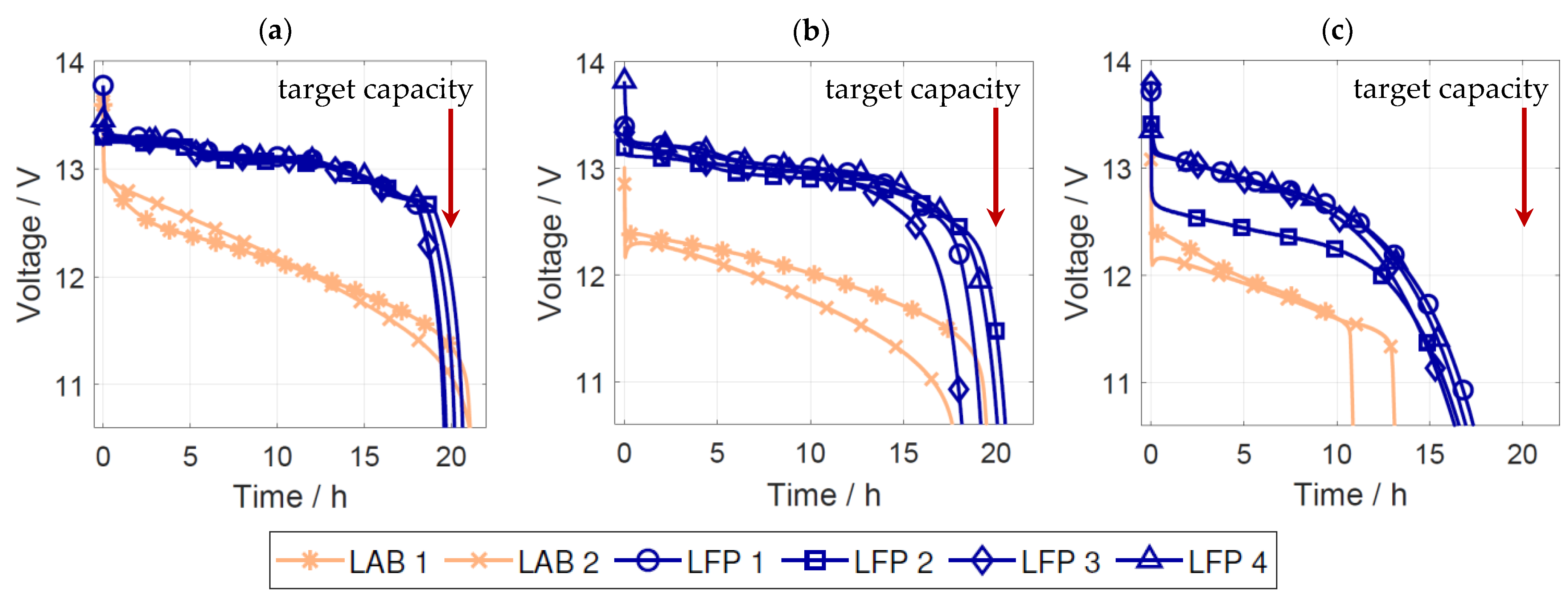
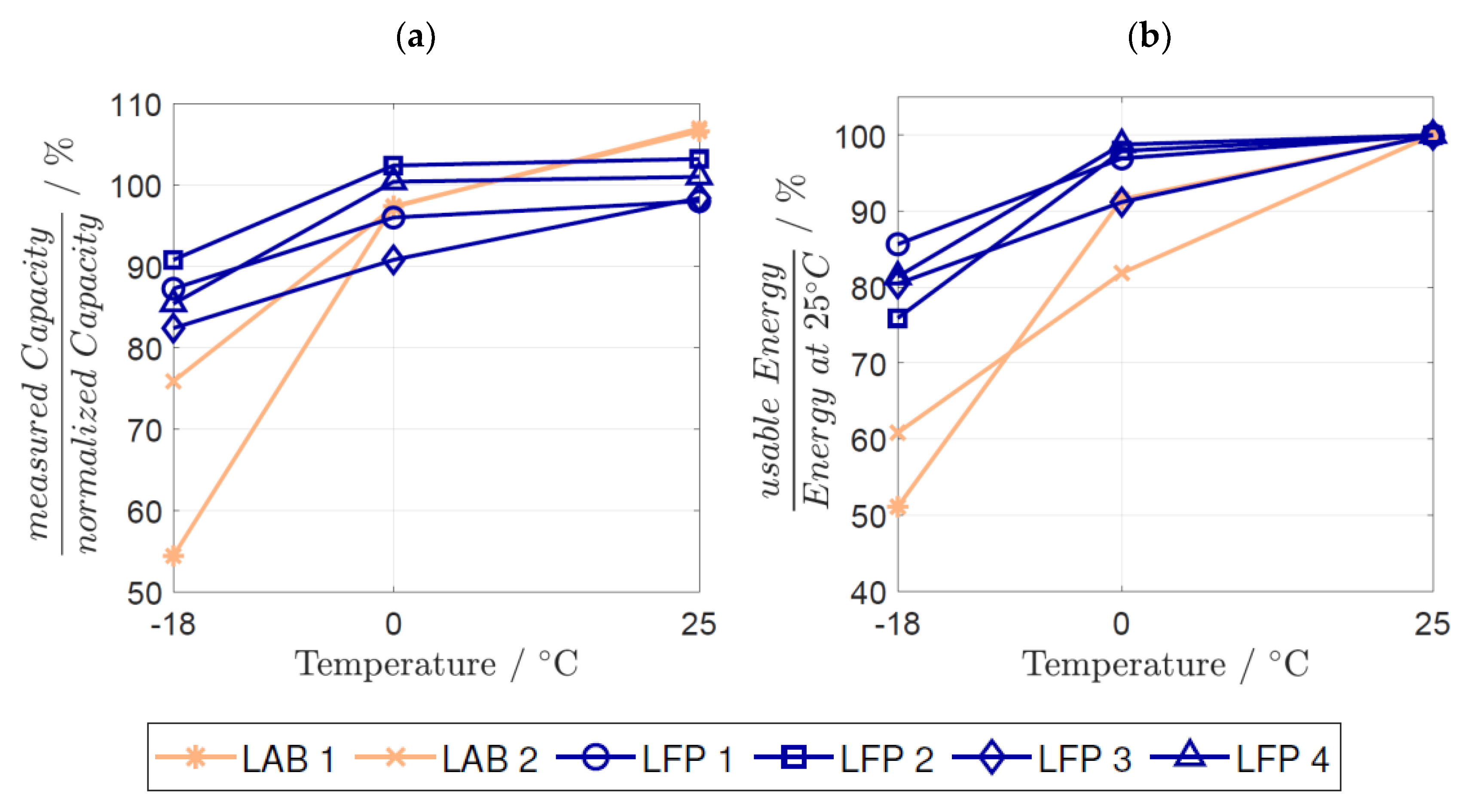

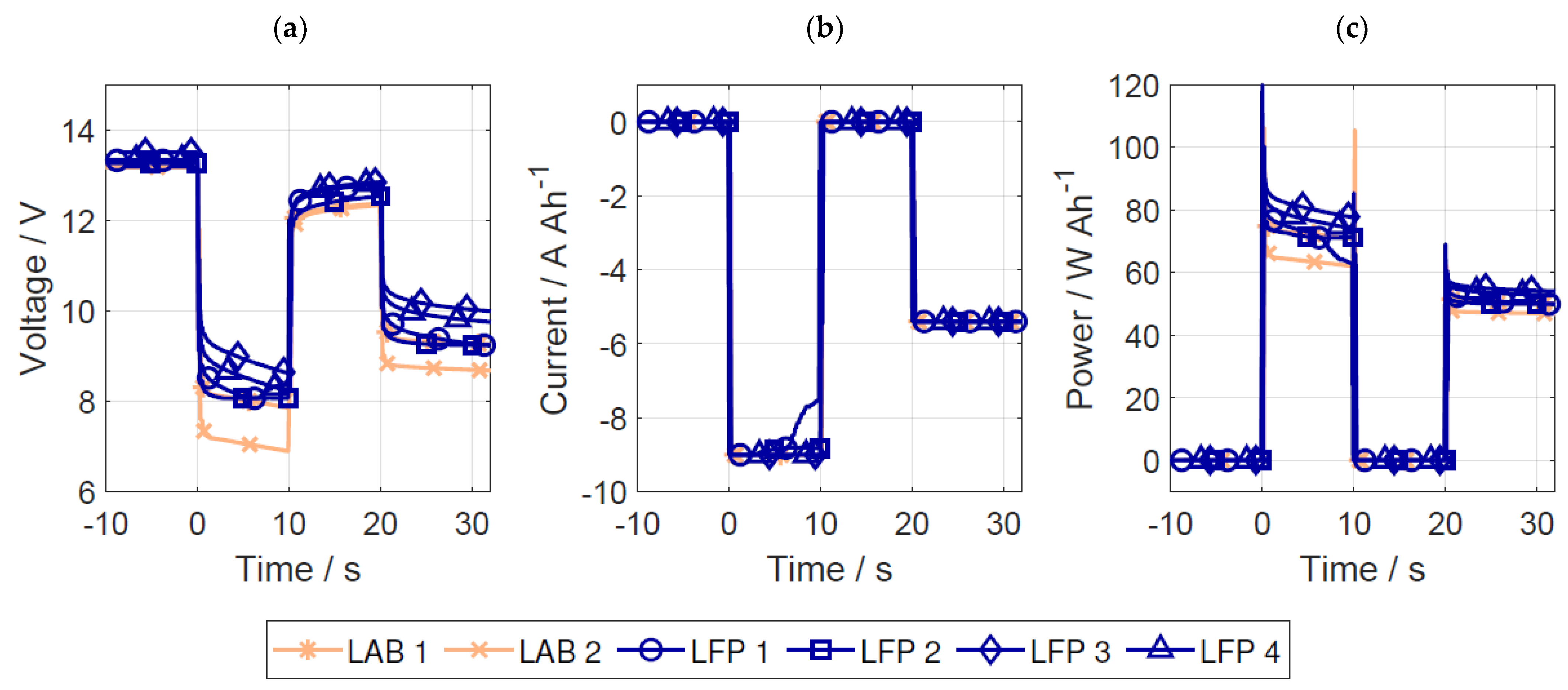
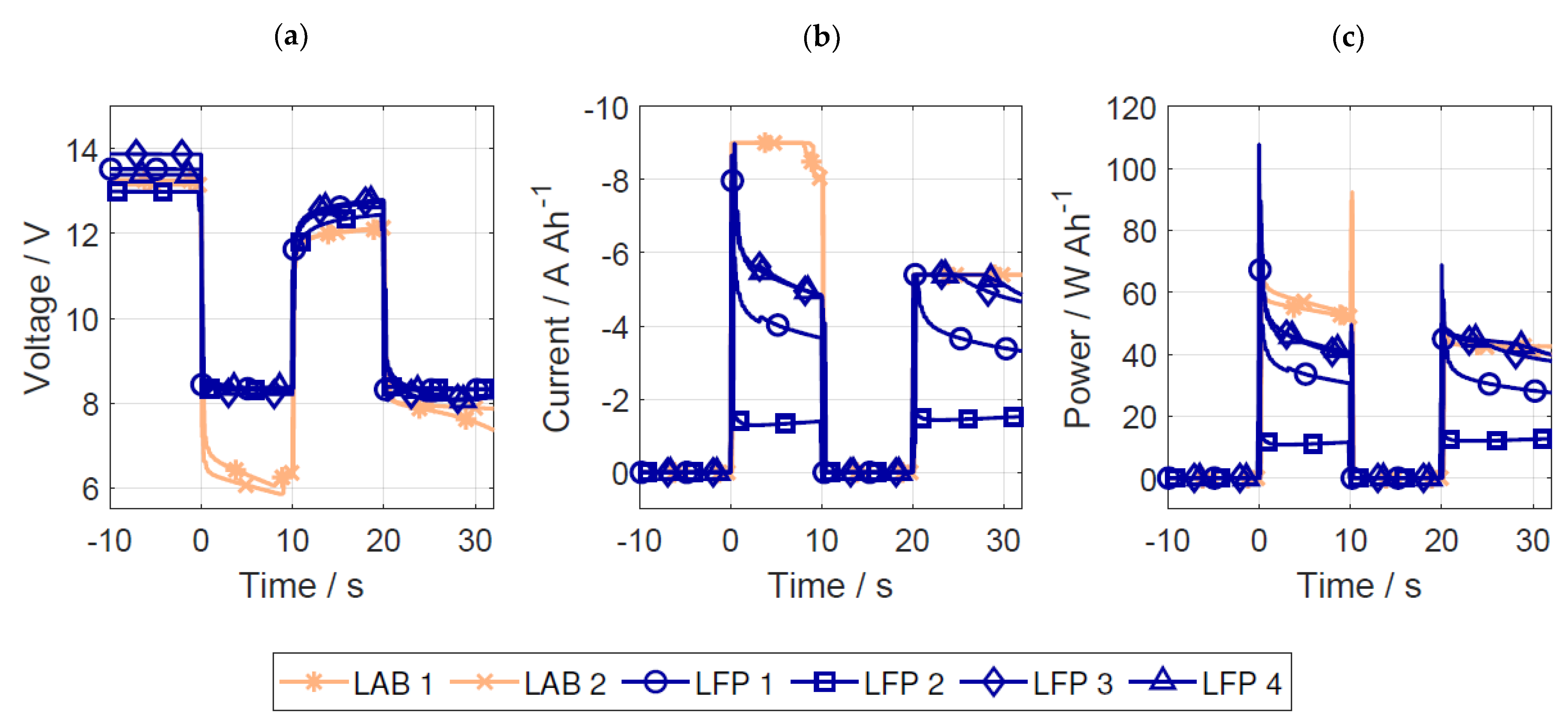
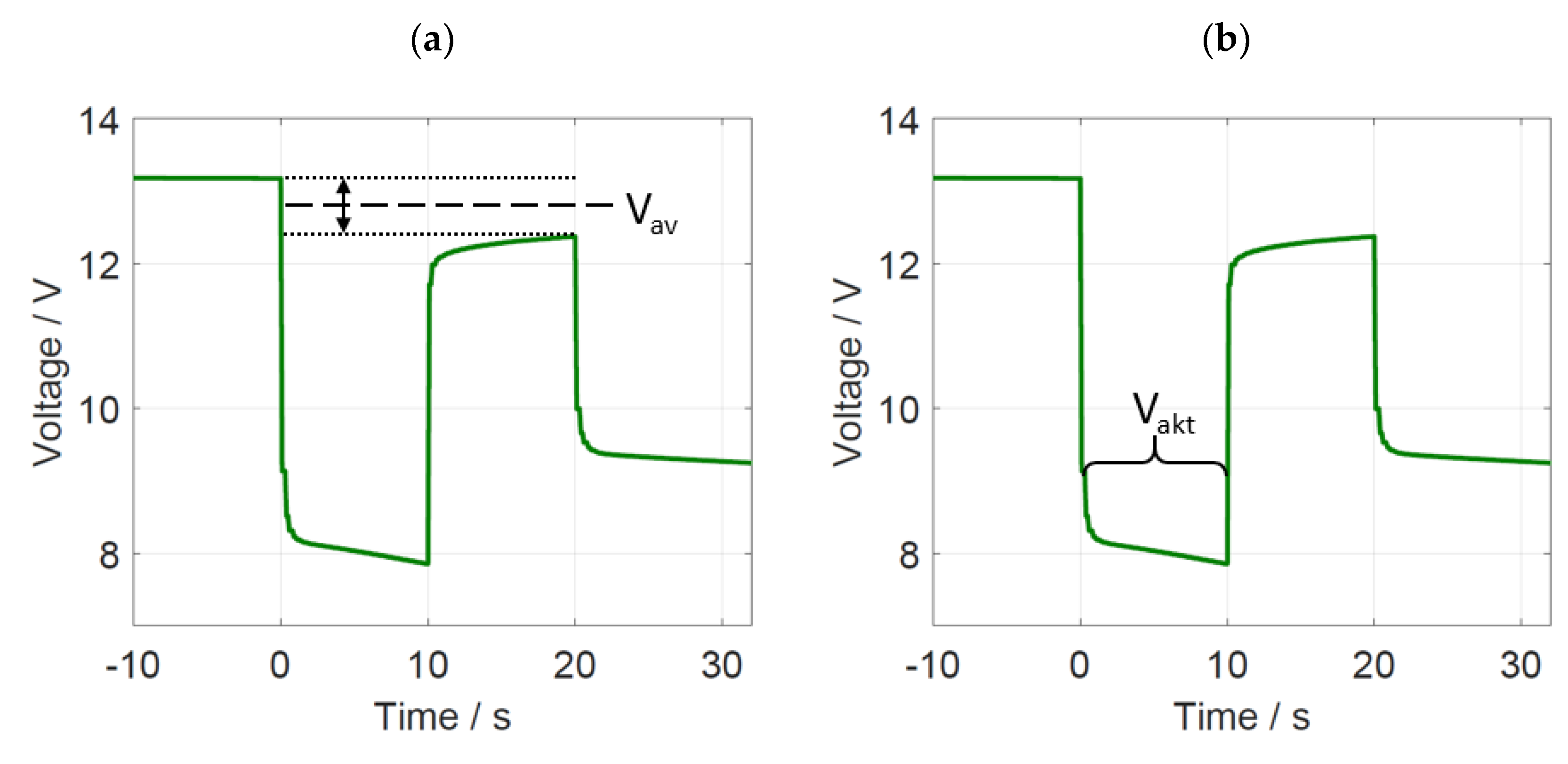
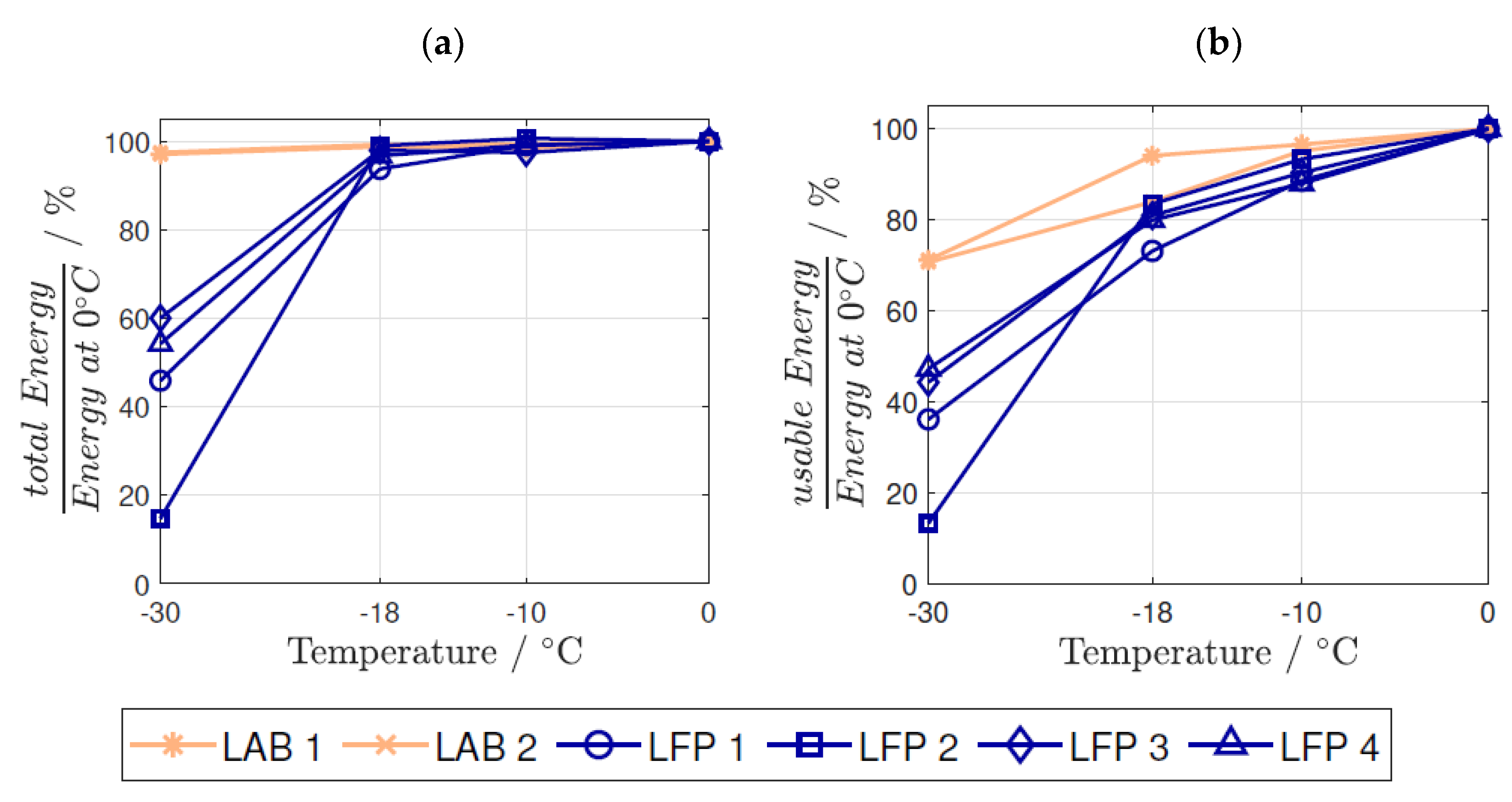
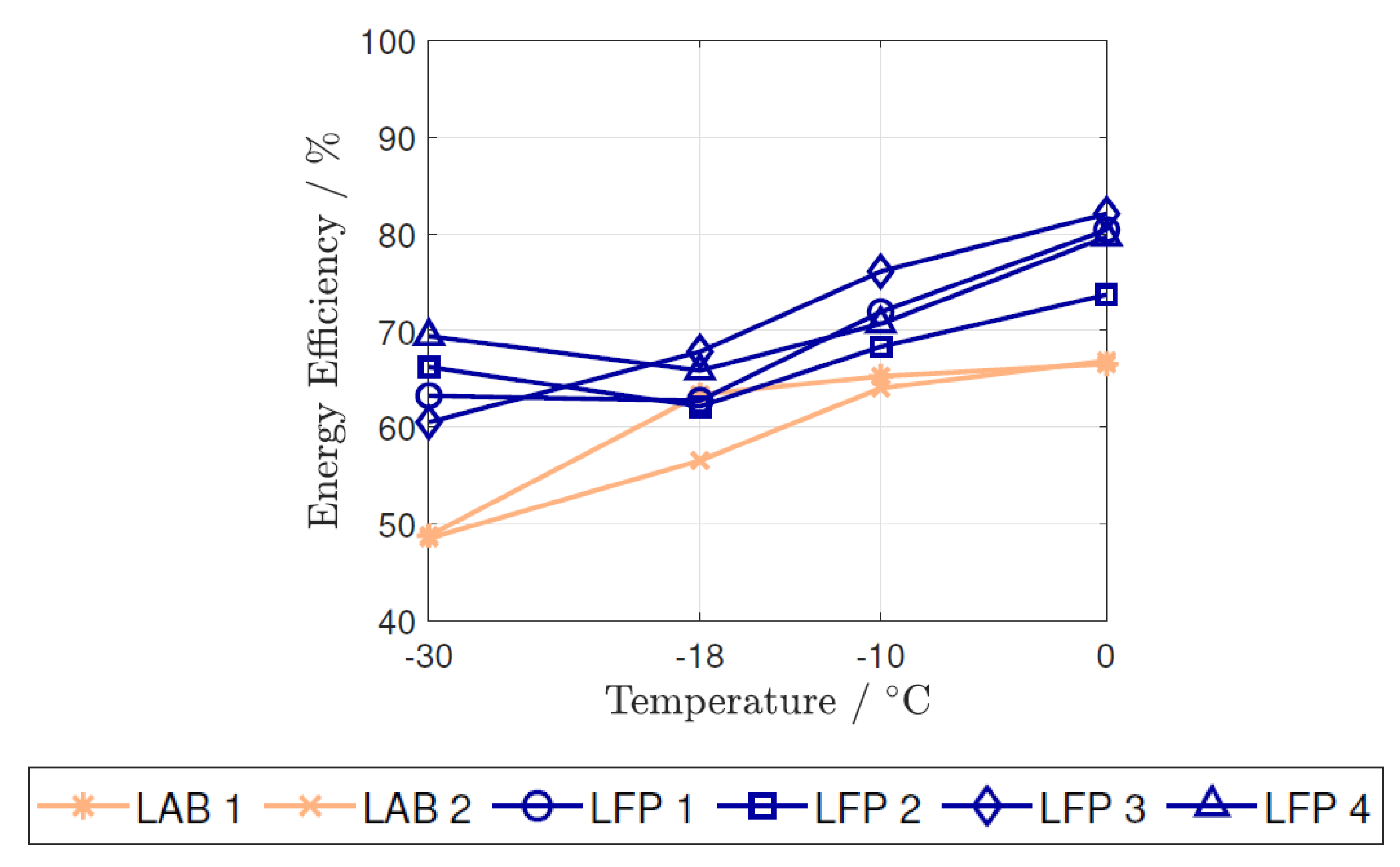
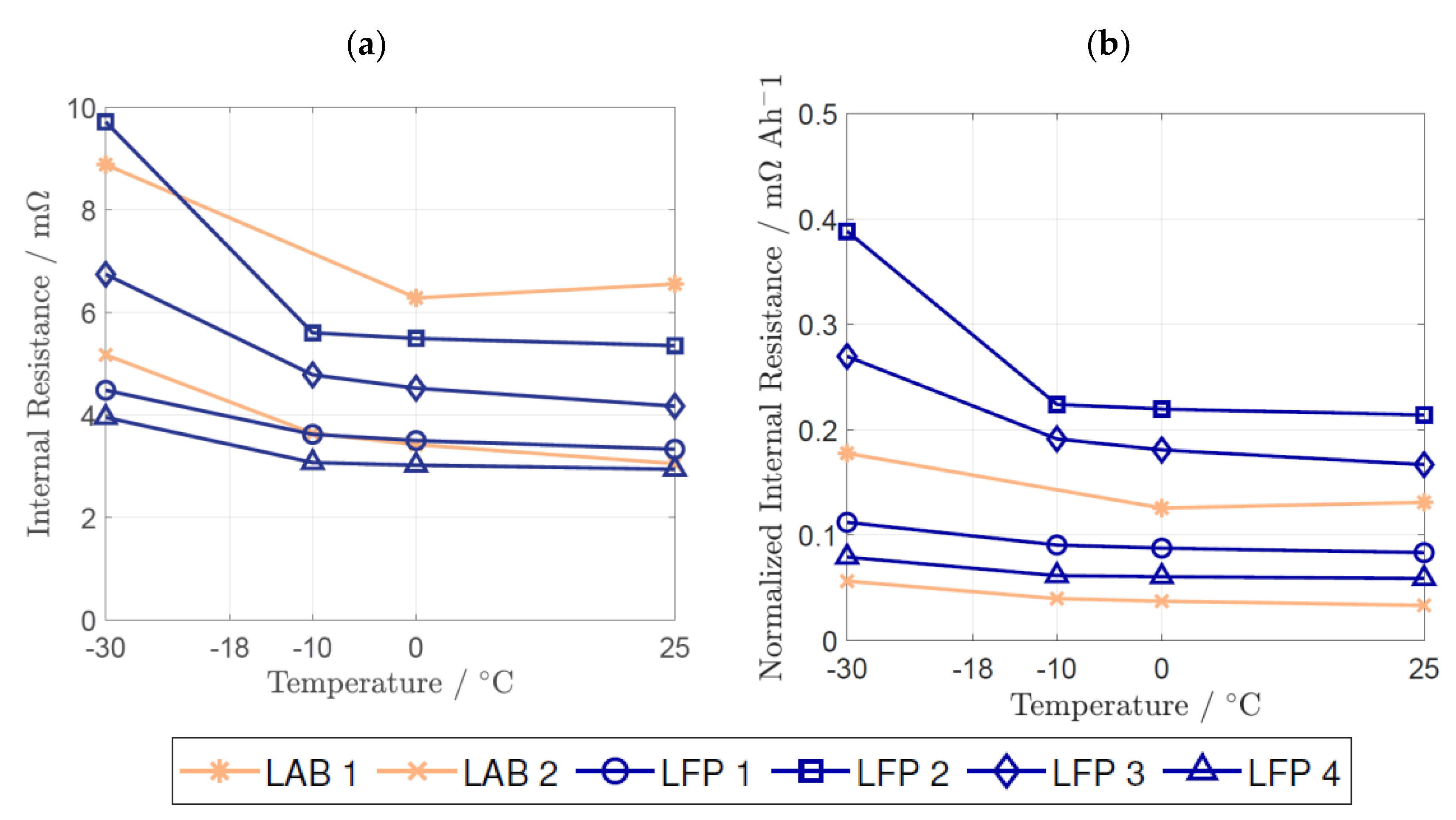

| Engine | −28 °C | −20 °C | 0 °C | 20 °C | 40 °C |
|---|---|---|---|---|---|
| 6-cylinder Otto | 380 A | 350 A | 290 A | 290 A | 290 A |
| 8-cylinder Otto | 400 A | 370 A | 310 A | 310 A | 310 A |
| 4-cylinder Diesel | 460 A | 430 A | 370 A | 370 A | 370 A |
| 6-cylinder Diesel | 620 A | 590 A | 520 A | 520 A | 520 A |
| ID | Nominal Capacity | Measured C20 Capacity at 25 °C | Battery Layout | Company | Internal Resistance at 25 °C | Weight | Dimensions |
|---|---|---|---|---|---|---|---|
| LAB 1 | 50 Ah | 53.3 Ah | 6S1P | A | 6.55 mΩ | 12.5 kg | 207 × 175 × 190 mm |
| LAB 2 | 92 Ah | 98.4 Ah | 6S1P | A | 3.05 mΩ | 27.0 kg | 352 × 175 × 190 mm |
| LFP 1 | 40 Ah | 39.2 Ah | 4S15P | B | 3.33 mΩ | 7.0 kg | 277 × 175 × 190 mm |
| LFP 2 | 25 Ah | 25.8 Ah | 4S10P | C | 5.35 mΩ | 4.4 kg | 220 × 120 × 190 mm |
| LFP 3 | 25 Ah | 24.6 Ah | 4S10P | D | 2.94 mΩ | 3.4 kg | 107 × 135 × 150 mm |
| LFP 4 | 50 Ah | 50.5 Ah | 4S20P | D | 4.17 mΩ | 6.6 kg | 210 × 135 × 150 mm |
| Test Sequence | Ambient Temperature | Focus |
|---|---|---|
| 1st Test | 25 °C | C20 Capacity Test |
| 2nd Test | 0 °C | |
| 3rd Test | −18 °C | |
| 4th Test | 0 °C | Cold-Cranking Test |
| 5th Test | −10 °C | |
| 6th Test | −18 °C | |
| 7th Test | −30 °C |
| C20 Capacity Test | Cold-Cranking Test | ||
|---|---|---|---|
| ID | Discharge Current | Discharge Current 1st Pulse | Discharge Current 2nd Pulse |
| LAB 1 | 2.5 A | 450 A | 270 A |
| LAB 2 | 4.6 A | 828 A | 497 A |
| LFP 1 | 2 A | 360 A | 216 A |
| LFP 2 | 1.25 A | 255 A | 135 A |
| LFP 3 | 1.25 A | 225 A | 135 A |
| LFP 4 | 2.5 A | 450 A | 270 A |
| ID | Ambient Temperature | Passing the Standard | Average Power 1st Pulse | Average Power between 20 s and 60 s |
|---|---|---|---|---|
| LAB1 | 0 °C | passed | 77.4 W Ah−1 | 51.7 W Ah−1 |
| −10 °C | passed | 74.8 W Ah−1 | 50.3 W Ah−1 | |
| −18 °C | passed | 72.8 W Ah−1 | 49.4 W Ah−1 | |
| −30 °C | not passed | 55.1 W Ah−1 | 20.6 W Ah−1 | |
| LAB2 | 0 °C | passed | 77.3 W Ah−1 | 52.3 W Ah−1 |
| −10 °C | passed | 73.6 W Ah−1 | 50.2 W Ah−1 | |
| −18 °C | passed | 64.8 W Ah−1 | 46.6 W Ah−1 | |
| −30 °C | not passed | 54.6 W Ah−1 | 41.7 W Ah−1 | |
| LFP1 | 0 °C | passed | 96.8 W Ah−1 | 61.1 W Ah−1 |
| −10 °C | passed | 85.8 W Ah−1 | 55.8 W Ah−1 | |
| −18 °C | not passed | 70.8 W Ah−1 | 49.7 W Ah−1 | |
| −30 °C | not passed | 35.0 W Ah−1 | 27.1 W Ah−1 | |
| LFP2 | 0 °C | passed | 85.3 W Ah−1 | 55.2 W Ah−1 |
| −10 °C | passed | 79.6 W Ah−1 | 52.9 W Ah−1 | |
| −18 °C | not passed | 71.2 W Ah−1 | 50.5 W Ah−1 | |
| −30 °C | not passed | 11.3 W Ah−1 | 13.5 W Ah−1 | |
| LFP3 | 0 °C | passed | 99.4 W Ah−1 | 62.2 W Ah−1 |
| −10 °C | passed | 89.8 W Ah−1 | 58.1 W Ah−1 | |
| −18 °C | passed | 80.4 W Ah−1 | 54.0 W Ah−1 | |
| −30 °C | not passed | 44.0 W Ah−1 | 38.2 W Ah−1 | |
| LFP4 | 0 °C | passed | 97.1 W Ah−1 | 61.5 W Ah−1 |
| −10 °C | passed | 85.6 W Ah−1 | 56.8 W Ah−1 | |
| −18 °C | passed | 77.6 W Ah−1 | 52.7 W Ah−1 | |
| −30 °C | not passed | 45.8 W Ah−1 | 40.4 W Ah−1 |
Disclaimer/Publisher’s Note: The statements, opinions and data contained in all publications are solely those of the individual author(s) and contributor(s) and not of MDPI and/or the editor(s). MDPI and/or the editor(s) disclaim responsibility for any injury to people or property resulting from any ideas, methods, instructions or products referred to in the content. |
© 2023 by the authors. Licensee MDPI, Basel, Switzerland. This article is an open access article distributed under the terms and conditions of the Creative Commons Attribution (CC BY) license (https://creativecommons.org/licenses/by/4.0/).
Share and Cite
Bauknecht, S.; Wätzold, F.; Schlösser, A.; Kowal, J. Comparing the Cold-Cranking Performance of Lead-Acid and Lithium Iron Phosphate Batteries at Temperatures below 0 °C. Batteries 2023, 9, 176. https://doi.org/10.3390/batteries9030176
Bauknecht S, Wätzold F, Schlösser A, Kowal J. Comparing the Cold-Cranking Performance of Lead-Acid and Lithium Iron Phosphate Batteries at Temperatures below 0 °C. Batteries. 2023; 9(3):176. https://doi.org/10.3390/batteries9030176
Chicago/Turabian StyleBauknecht, Sophia, Florian Wätzold, Anton Schlösser, and Julia Kowal. 2023. "Comparing the Cold-Cranking Performance of Lead-Acid and Lithium Iron Phosphate Batteries at Temperatures below 0 °C" Batteries 9, no. 3: 176. https://doi.org/10.3390/batteries9030176
APA StyleBauknecht, S., Wätzold, F., Schlösser, A., & Kowal, J. (2023). Comparing the Cold-Cranking Performance of Lead-Acid and Lithium Iron Phosphate Batteries at Temperatures below 0 °C. Batteries, 9(3), 176. https://doi.org/10.3390/batteries9030176







